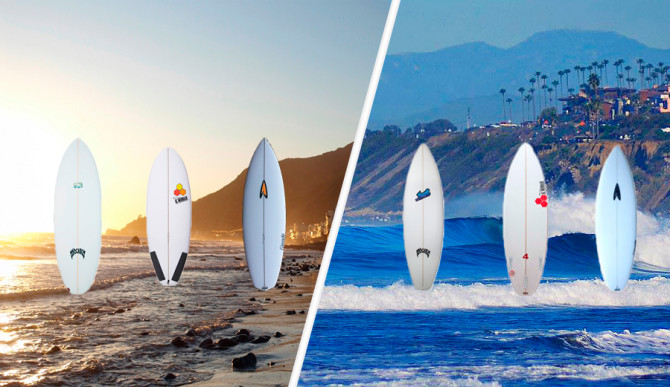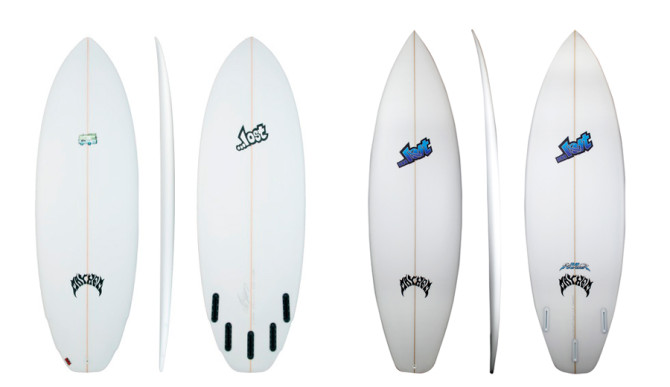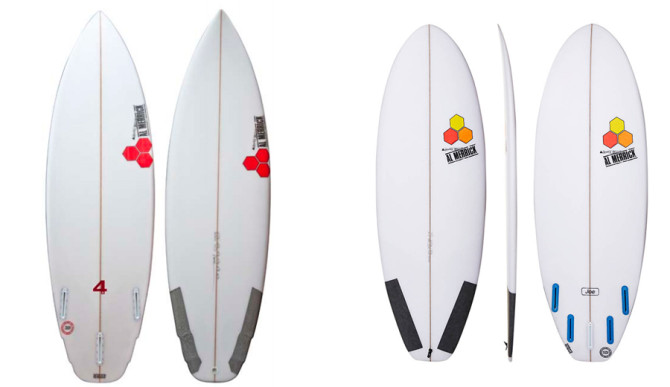Author’s Note: In the comments, please feel free to suggest more of your seasonally versatile boards. These suggestions are far from complete.

Get your California quiver right.
The surf industry and the surfer‘s industry disagree on one huge thing: what is sexy during summer? The surf industry uses summer to publish the sexiest pictures of the leanest, tallest, most modernly attractive women to sell bikinis. The surfer’s industry uses summer to sell us the fattest, shortest, and sometimes just plain hideous shapes. But what happens when winter comes around? Do we throw away the short, ugly one for our slender winter beauty?
Surfers rarely have the money to fill out their quiver for all seasons, but some of these “curvier” (to be polite) summer shapes don’t transition well in bigger waves. Below are three pairs of boards from West Coast shapers that seem to make the cut, loosely picked for a California surfer’s seasonal transition with one fatter shape (more summer/mush-minded) and one a little more high performance (better for the winter transition).

The RV (L) and Sub Scorcher (R).
…Lost RV or Sub Scorcher
The RV is one of the newest “Domesticated Series” boards by Matt Biolos. More than any other of the series (perhaps with the exception of the Bottom Feeder), this thing performs well and keeps things tight in small surf. The double-bump tail narrows out to keep arcs tight in tiny pockets, while the bumps (conceptually different from wings) actually create more drive than pivot. This tail is also great in bigger/more powerful waves, as it sticks to the face better and won’t slide out if you don’t want it to. This tail is practically the same as the #4 by Channel Islands, below.
The Sub Scorcher is meant to be ridden a little longer than the Sub Scorcher II, which came out this year. Having the option of a little extra length opens up to comfortably riding bigger waves, so the original Sub Scorcher (just barely) wins as the better transitional board. This is actually a go-to when it is belly-high to a little overhead. The subtle hip in front of the fins makes it really snappy, and a moderate single concave through the tailblock keeps it powerful coming out of turns. As a transitional board, go a liter between your traditional groveler and your stock shortboard (probably not a bad rule for all of these suggestions).

#4 Groveler (L) and Average Joe (R).
Channel Islands #4 Groveler or Average Joe
The #4 is Dane Reynolds’ new, weird release for California waves. You can actually order it in two different predetermined sets of dimensions: “groveler” or “utility.” Both do well in smaller, weaker waves. The difference? Yup, you got it: shorter, fatter and floatier in the groveler dimensions. Like the RV, the double-bump tail creates a ton of drive, and the thin tail vs. thickness at the wide point creates a generous sweet-spot and keeps paddling easy. In bigger waves, the bumped tail (like the …Lost RV) keeps it from sliding out when there is a lot of speed. Go “utility” dimensions if you will surf it in mostly chest-high-plus, but note that it will still work in smaller waves pretty decently.
The Average Joe is great in small waves simply because it is so damn thick and wide. This thing makes sections you would never, ever expect to. It isn’t great in overhead waves, and it barely made the list, but there is a catch that a lot of people should know about, so here is an opportunity to share: If you have the money for a custom board (and that is a huge “if” with CI), you can order this board with the tail from the #4 (not available in the online builder). The #4 tail will make it slide out a little less, making it a better board going into winter, while also making it drivier for summer. With the stock squash, the tail blows out super-easily, which can be fun, but it becomes a problem in bigger waves. It’s all preference, but the #4 tail is slightly more versatile for bigger waves and the Average Joe can become a good compromise for scoring on crowded winter weekends with swell.

White Diamond 2 (L) and The Lip (R).
Roberts White Diamond 2 or The Lip
Diamond tails really slipped under the radar with the whole “fat and wide” revolution. They have three defined points to turn off of, making shorter, thicker boards turn a little more precisely and controlled than most other tails. Outside of contests, Julian Wilson is now using this tail on his Sub Scorcher II in all sizes of waves. Dane loved the Roberts White Diamond and his CI Dumpster Diver was modeled after it. The original White Diamond is thick enough to get speed in slop, but the diamond tail creates extra hold in overhead waves, like a pintail blended with a squaretail (talk about versatile). With the narrower tail and slimmer overall profile, the White Diamond 2 works better than the original in bigger waves, but if you want it mostly for bigger waves, Roberts also makes a Black Diamond model that is a little leaner in all dimensions.
This is the oldest of all of these options (perhaps except for the Sub Scorcher), but it is incredible that it was missed by pretty much everyone. For the width and thickness of this board, it surfs close to a stock shortboard. There is no wonder to why Robert Weiner has deemed it a “betweener”; this board will feel comfortable in typical California waves heights from waist high to a couple feet overhead. The deep single concave through the majority of the board makes it really quick and snappy, while opening it up to holding well in bigger waves.
Again, please share your best transitional boards below, and help others make the transition into winter cheap and fun.

